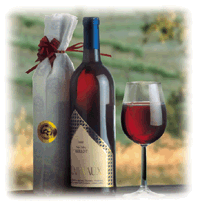Cool wines from Chile
 The answer is Argentina. The question, of course, is which wine-producing country makes the best wines for the price? Chile has owned that distinction for a number of years, and certainly hasn`t lost its touch. If anything, the wines of Chile are better than ever and continue to be a great value.
The answer is Argentina. The question, of course, is which wine-producing country makes the best wines for the price? Chile has owned that distinction for a number of years, and certainly hasn`t lost its touch. If anything, the wines of Chile are better than ever and continue to be a great value. "The truth is, Chile makes very good wines and will continue to make very good wines," said Brett Crittenden of Terrazas de Los Andes, the new Argentine label being introduced to the U.S. market this month. "But Argentina has the potential to make great wines."
This is no idle boast. Investment from world-renowned wine companies has been flowing south to Argentina for the past 10 years, boosting a wine industry that had seldom before factored quality into the equation.
"The thing many people in the business remember about Argentine wineries is that they used to brag about the fact they got 25 tons to the acre," said Crittenden. "Modern viticultural practices and an emphasis on lower yields and quality grapes have turned everything upside down. And there are some wonderful 50-, 60- and 70-year-old malbec and cabernet vines."
Terrazas was created by Moet & Chandon, the French Champagne house. Seagrams Chateau & Estates owns San Telmo, another new brand; Allied Domecq recently introduced wines under the Balbi label; and Kendall-Jackson`s Artisans & Estates division is producing an Argentine wine called Tapiz. What they all have in common is excellent quality at a reasonable price, generally less than $15 a bottle for the red wines. The Terrazas 1999 Alto Malbec, Cabernet Sauvignon and Chardonnay all retail for $10. Terrazas also produces a $35 Gran Malbec and Gran Cabernet Sauvignon - both superb wines from the 1997 vintage - and will release a line of reserve wines in the $20 range sometime after the first of the year.
"The $35 wines might meet some initial resistance," said Crittenden, "until people realize these are special limited-production wines from 70-year-old vines planted in one of the best climates in the world for wine grapes."
The primary source of fine wine grapes in Argentina is the Mendoza region west of Buenos Aires.
"It`s essentially a desert, with very little water," said Crittenden. "The high altitude gives the grapes tremendous temperature extremes between night and day, and hence there is a long growing cycle with the ability to fully ripen each grape variety to the optimum."
Malbec, one of the five grape varieties permitted in Bordeaux, makes the best Argentine wines, but cabernet sauvignon, merlot and syrah do very well.
"I used to think it was the clone of malbec used in Argentina that made it so good," said Crittenden. "But the same clones have been planted in California and elsewhere and it makes a dog of a wine. It really is the altitude, climate and soil."WINE FINDS
The most outstanding wines are rated Exceptional. Wines that earn high marks for complexity, balance and flavor are rated Very Good. Wines that represent excellent quality for the price are rated Good Value.
Exceptional:
Iron Horse 1997 "Benchmark," Alexander Valley ($50), is a richly layered red meritage that would no doubt command a substantially higher price tag were it from the Napa Valley. Never mind the reality that Bordeaux varietals from the Alexander Valley are every bit as good as those from the Napa Valley.
This wine has it all: texture, structure, concentration, complexity and pure fruit aromas. For the record, the blend is mostly cabernet sauvignon, with 12 percent merlot and 12 percent cab franc.
Byron 1997 Pinot Noir, "Sierra Madre Vineyard" ($32), is one of the finest efforts to date from this Santa Barbara County winery. The chardonnay from Byron generally steals the pinot noir thunder, and the 1997 Byron Estate Chardonnay ($32) is no less good than usual. But this time the pinot noir gets the edge, particularly for those who prefer red wines to whites.
Very Good:
Baileyana 1999 Sauvignon Blanc, San Luis Obispo County ($13), is a throwback to a time when California winemakers weren`t trying to make sauvignon blanc taste like chardonnay. This fresh, crisp wine from California`s Central Coast is a delightful example of the herbal/citrus style of sauvignon blanc that was once in vogue.
Napa Wine Company 1999 Sauvignon Blanc, Napa Valley ($18), is more in the currently popular style, which means it has the imprint of oak fermentation and aging that often can mask the subtle complexities of the fruit. That`s not the case here. Aromas of pineapple, grapefruit and fig and a slight herbal/mineral note stamp this wine as pure, 100 percent sauvignon blanc.
Errazuriz 1999 Chardonnay "Wild Ferment", Chile ($22), will meet resistance in this price range because most consumers expect white wines from Chile to come from the bargain bin. But there are excellent white wines being made there, particularly the chardonnay from the cooler Casablanca Valley. This Casablanca chard is from one of Chile`s top producers and it was fermented using "native" or natural yeasts, which is riskier, but more rewarding, than conventional fermentation techniques with commercial yeasts. So you do the math. For the quality in the bottle, it`s a fair price.
Good Value:
Errazuriz 1999 Chardonnay, Chile ($9.99), is one of those wines for less than $10 that impresses because of its balance, purity and simplicity. Quality is very high and the winemaker allowed the wine to be what it is without needlessly tweaking it.
Rosemount Estate 1999 Sauvignon Blanc, Australia ($8), is another yummy, well-balanced white wine that is plenty satisfying, if not dazzling.
Terrazas 1999 Malbec, Argentina ($10), provides a generous clue concerning the emerging quality from this previously lackluster wine-producing country. The malbec is delightful and an exceptional value. The cabernet sauvignon ($10) is good, too, though a bit herbal in the nose and not as immediately appealing as the malbec.
Serving suggestion: All too often, sparkling wine is reserved for the celebratory toast. Bubbles are more versatile than you think. They awaken the palate when served before dinner, or pair up nicely with an array of first courses, main courses and desserts. Lighter, less expensive Champagnes and sparkling wines work best with appetizers and soft cheeses. A vintage Champagne or prestige cuvee has enough power and complexity to stand up to many a main course, from fish to poultry to sweetbreads. Generally speaking, spicy or salty dishes also work well with bubbly. Don`t forget Champagne is wine and meant to be served with food.
Visit Robert Whitley online at www.whitleyonwine.com or send e-mail to him at whitonwine@aol.com.
(c) Copley News Service
advertisement

Related Articles
Author: Robert Whitley
Archives
Vintage port is built to last
California`s Chalone making a comeback
Dining well in California wine country
Ports are more durable than most wines
Grappling with grapes
The many glories of grappa
A wealth of great wine
The seismic shifts at Chandon
The readers always write
Here`s all the news that`s fit to vint
A wine with wheels
Robert Mondavi`s California dream
A level playing field at the Monterey Wine Competition
Fine wines can still be kosher
You`ll appreciate your older wine more than it appreciated
More Articles







